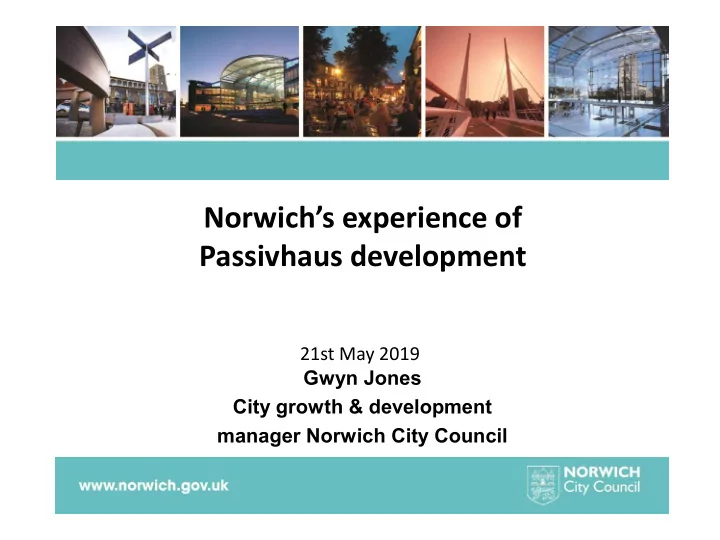

Norwich’s experience of Passivhaus development 21st May 2019 Gwyn Jones City growth & development manager Norwich City Council
Why passivhaus? Housing Strategy 2013- To build • minimum of 250 new council homes, let at social rent by 2018 Environmental Strategy 2015 • Priority 5-To ensure that new • development is carried out in a sustainable way. Target – 2015-2019- 100% of • new homes built by the council to sustainable Homes Code 4 or passivhaus
Norwich’s passivhaus schemes Norwich City Council Hansard close - 10 • social units completed May 2017 Architects Hamson • Barron Smith Contractor EN Suiter •
Norwich’s passivhaus schemes Norwich City Council Goldsmith street - 93 social • units – almost complete. Architects: Mikhail Riches • Contractor RG Carter • Multi award winning! •
Norwich’s passivhaus schemes Norwich Regeneration Ltd Rayne Park - 172 units (112 • passivhaus) under construction. Due for completion Autumn 2020 • Largest mixed tenure (& tenure • blind) passivhaus scheme in UK Part of 1000 home development • Architects Hamson Barron Smith • Contractor RG Carter •
Challenges Planning policy Greater Norwich Joint Core Strategy 2014 Policy 3 Decentralised & renewable energy to • provide at least 10% of expected energy requirements Larger schemes to maximise provision • of energy from decentralised & renewable energy Policy emphasis on renewables, district • heating not “fabric first” Scheme emphasis on energy efficiency • not energy generation (MVHR not photo voltaics)
Challenges Busting the “myths” Residents need to lead a • different lifestyle Controls too complicated • Can’t open windows! • Homes will overheat •
Challenges Technical considerations Designing passivhaus from outset • Orientation • Simple building form- size and shape • Shading strategy Contractor experience • Fabric First Framework Quality control • New ways of working and attention to detail • Fabric First Academy
Solar shading Norwich Drawloom Shawl (1840) an important shawl for Norwich as it is one of the very few which can be safely attributed to Willett & Nephew, one of the largest and most influential shawl manufacturers in the city.
Challenges Financial Higher build costs • Management- components • more expensive to replace/ maintain but whole life costs Contractor building in risk • Returns-uncertainty around • premium on private sales
Challenges For purchasers/ tenants Induction hobs- need to buy • special pans Perceptions- ability to switch off • the MVHR Noise of MVHR and hearing • problems It’s not air conditioning! •
Benefits of passivhaus Social Reduced energy bills- up to • 70% Addressing fuel poverty • Reducing rent arrears to 0% • Health benefits- air quality- • sleep, allergies etc No noise; no mould • Overall tenant satisfaction •
Performance & monitoring
Monitoring data 85.7% said they would now either prefer to live in a Passivhaus or only move if it was into • another Passivhaus 100% were satisfied to very satisfied with their energy bills • 85.7% said that using the heating was the same or easier than they were used to • No residents said it was difficult to use the ventilation system • 85.7% said it was comfortable to very comfortable in their homes all year round • 100% said the maintenance of their Passivhaus was the same or easier than they were • used to.
Benefits of passivhaus Economic: Upskill local workforce • (Building Futures in Norwich Fabric First Academy) Opportunities for • local businesses Sales premium •
Benefits of passivhaus Environmental: No “performance gap” compared • with Building Regs 2013 Actual performance of new • homes does not match design- (Average new home likely to use 40% more energy than predicted) Notionally zero carbon home • would still emit 18kg co2/m2 .year ( Source- Passivhaus- The Route to Zero Carbon?- Passivhaus Trust 2019)
Future- practical issues For the council/ Norwich Regeneration Ltd Build cost- quantity v quality for • council Experience of residents- energy • savings- need for monitoring/ evidence Advance resident briefings • Delivering best financial return for • council USP for company •
Future- Local planning policy GNLP proposed draft policy based on • interpretation of 2015 Written Ministerial Statement- local authorities can set standards above Building Regs but not exceed equivalent of Code for Level 4. Level 4 agreed to be equivalent to • 19% improvement on Part L of 2013 Building Regs. Consideration of introduction of • national standard to prevent use of fossil-fuel heating in new homes
Future national policy considerations Passivhaus- only way to achieve zero carbon Performance gap • Disparity between energy demand • (heating in winter) & renewable energy generation- requirement for storage/ storage losses Limit on amount of energy managed & • deployed through national grid Non passivhaus would require 28 solar • panels to offset energy usage. (Passivhaus would need only 14 solar panels.) (Source- Passivhaus- The Route to Zero Carbon?- Passivhaus Trust 2019)
Conclusions Reducing heating energy demand • through a fabric first approach is only practical way to achieve zero carbon homes in reality. Local authority housebuilding can set • an example and share the learning/ wider (non environmental) benefits Costs will come down if more • projects developed Private housebuilders are unlikely to • change practice voluntarily This can only be achieved through • national policy standards
Questions?
Recommend
More recommend